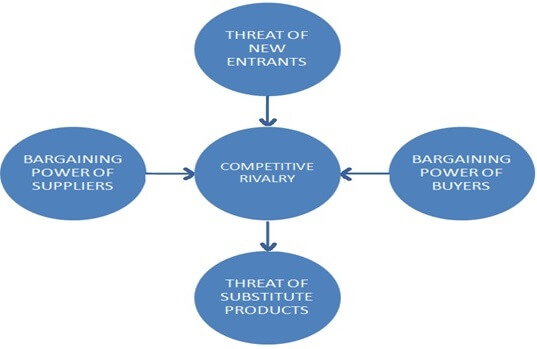Michael Porter's Five Forces Model Assignment Help
Michael Porter gave the Five Forces Model of competition. It was published in Porter’s book "Competitive Strategy: Techniques for Analyzing Industries and Competitors" in the year 1980. The model focuses on the factors that determine the profitability of firms within various industries. It is of great significance for formulating business strategies. The five forces are described as the micro environment (because these are industry and firm specific). According to this model, an “unattractive” industry is where all these factors lead to a reduction in profitability.
The model is best illustrated through the given diagram:

The five forces in Michael Porter’s model are discussed as follows:
COMPETITIVE RIVALRY
It describes the extent of competition, i.e., the number of existing firms in the industry. This is quantitatively measured by the Concentration Ratio. This ratio shows the Brand Management Tutors of the leading firms in the industry. The intensity of competition strongly influences the profits of a firm. The larger the number of firms, the easier it is for the customers to strike out a better deal with the competitors. In order to overcome this force, the firm has to adopt strategies such as maintain competitive prices, improve product quality and features, build strong relations with suppliers and buyers and use appropriate channels of distribution to provide ease of purchase to the buyers.
THREAT OF NEW ENTRANTS
Not only the incumbent firms, but also, the new firms entering into the market are a source of competition. This factor explains the threat posed by the entry of new firms into the industry. Rise in the number of firms would lead to a threat on the market share of the firm leading to a challenge on maintaining the profits. Barriers to entry of new firms is a method to overcome this threat. These barriers can be in the form of governmental regulations, patents and copyrights and large initial capital requirement that the new firms may not be able to support.
BARGAINING POWER OF BUYERS
The bargaining ability of the buyers or customers also poses a serious threat. The bargaining power of buyers depends on the concentration of the buyers, the order size and the product differentiation in the industry. If the buyers purchase a large portion of the production or, have a significant order quantity, they can overpower the firms and vice versa. If the products of the different firms are well differentiated, it gives the firms an upper hand and the bargaining power of the buyers reduces. In case of a monopsony (a condition where there are many sellers and 1 buyer in the industry), the buyers have excessive bargaining power as they can threaten to shift to some other supplier.
THREAT OF SUBSTITUTE PRODUCTS
Under this model, substitute refers to a product of some other industry which can be substituted for the product of a given industry. This acts as a threat as the consumers may switch to the products of the other industry. The extent of threat posed by this factor depends on the ease of switching for the buyer, availability of a close substitute and relative price of the substitute. If it is easy for the consumers to substitute, it will also restrict the control over prices by the firms as they will constantly fear losing their customers.
Michael Porter's Five Forces Model Assignment Help By Online Tutoring and Guided Sessions from AssignmentHelp.Net
BARGAINING POWER OF SUPPLIERS
The suppliers include the factors of production. The suppliers bargaining power is also a strong threat to any business as if the suppliers are powerful, the firm will not have a good bargaining position, however, if the suppliers do not have a strong bargaining power, the firms ca easily bargain for the best price. Suppliers bargaining power is weak if there are many suppliers in the industry, weak integration among suppliers or easy availability of substitute inputs. On the other hand, suppliers have an upper hand when there are few suppliers or the suppliers are well integrated or there is absence of close substitute inputs or the supplier switching cost for the firms is very high.
Limitations of the Porter’s Five Forces model
The Porter’s five forces model of competition suffers from the following limitations:
- The model does not capture the dynamic market of the recent times. Today, the pace of change in market is immensely high. As a result, the model seems too static in relation to the current market structure.
- It is not suitable for a single firm. The model has a greater focus on the analysis of the entire industry.
- It involves clear demarcation of an industry and the 5 forces. This may become difficult in the current scenario with great interdependence and interrelation in the market players.
- The model only considers five forces, in reality, there can be several forces that may exert influence on an industry (such as governmental intervention).
- The model is based on competition. It assumes that the firms compete with each other. Other relations such as strategic alliances, virtual enterprise-networks are not explained.
- The model is applicable for exiting and established markets and is of little help for relatively new industries.
All these limitations point that the Porter’s five forces model is not perfectly applicable for industry analysis. However, the positive aspects of Porter’s five forces model cannot be ignored. The model provides useful insights to the management for strategic decision making and very efficiently captures five important market forces. Thus, it can be concluded that the model cannot be individually relied upon for strategy formulation. Rather, more than one model should be used for efficient strategising. For example: Porter’s five forces model in combination with the SWOT analysis can be used a comprehensive decision making and strategising tool.


